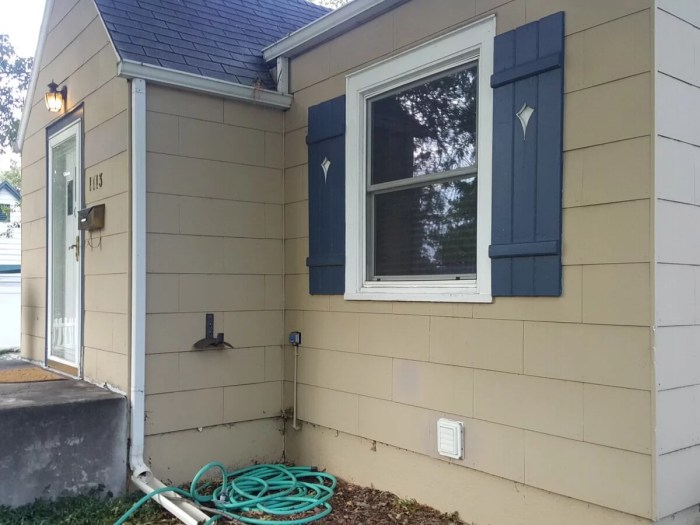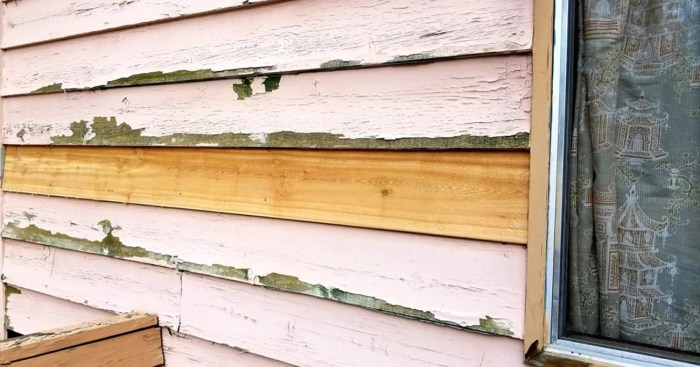Exploring Asbestos House Siding: A Comprehensive Guide
Delving into the realm of asbestos house siding unveils a rich history and a myriad of important considerations. From its origins to its potential health risks, this topic is as informative as it is intriguing.
As we navigate through the various aspects of asbestos house siding, a clearer picture emerges of its properties, associated risks, and the necessary steps for safe removal and replacement.
Introduction to Asbestos House Siding

Asbestos house siding refers to the use of asbestos-containing materials in the exterior cladding of residential buildings. Asbestos, a mineral known for its heat resistance and durability, was commonly used in construction before its health risks were widely recognized.
History of Asbestos Use in Construction
Asbestos gained popularity in the construction industry during the late 19th century due to its fire-resistant properties and strength. It was used in various building materials, including siding, roofing, insulation, and flooring. However, concerns about the health risks associated with asbestos exposure started to emerge in the mid-20th century.
Common Types of Asbestos Siding Materials
- Asbestos Cement Siding: This type of siding consists of asbestos fibers mixed with cement, creating a durable and weather-resistant material.
- Asbestos Shingles: Asbestos shingles were popular for their fire resistance and longevity, but they pose a health risk if damaged or disturbed.
- Asbestos Clapboard: Similar to traditional wooden clapboard siding, asbestos clapboard siding contains asbestos fibers for added strength and durability.
Properties of Asbestos Siding
Asbestos siding is known for its unique properties that make it a popular choice for construction. Let’s explore some key characteristics of asbestos siding.
Durability and Fire-Resistance
Asbestos siding is highly durable, able to withstand harsh weather conditions and resist damage from insects and rot. Its fire-resistant nature adds an extra layer of protection to the building, making it a preferred choice for safety-conscious homeowners and builders.
Comparison to Modern Siding Materials
When compared to modern siding materials such as vinyl or fiber cement, asbestos siding holds its own in terms of durability and fire-resistance. While newer materials may offer more design options and easier installation, asbestos siding remains a reliable and long-lasting option for those seeking a traditional look with added safety benefits.
Health Risks Associated with Asbestos Siding
Asbestos exposure poses serious health risks due to the harmful nature of asbestos fibers. When these fibers are inhaled or ingested, they can cause severe health issues over time.
Respiratory Problems
- Asbestos fibers can become lodged in the lungs, leading to respiratory issues such as difficulty breathing, coughing, and chest pain.
- Prolonged exposure to asbestos can result in serious conditions like asbestosis, lung cancer, and mesothelioma.
Increased Cancer Risk
- Asbestos exposure is known to increase the risk of developing lung cancer, especially in individuals who smoke.
- Mesothelioma, a rare form of cancer affecting the lining of the lungs or abdomen, is strongly linked to asbestos exposure.
Other Health Concerns
- Exposure to asbestos can also lead to digestive issues, as asbestos fibers can be swallowed and cause damage to the digestive tract.
- Skin irritation and other dermatological problems can occur if asbestos fibers come into contact with the skin.
Removal and Replacement of Asbestos Siding
When it comes to dealing with asbestos siding, removal and replacement must be done carefully to avoid health risks. Hiring professionals for this task is crucial to ensure safety and compliance with regulations.
The Process of Safely Removing Asbestos Siding
Removing asbestos siding involves several steps to minimize the release of harmful fibers into the air. Here are the key steps involved in safely removing asbestos siding:
- Assessment: A professional asbestos abatement contractor will assess the condition of the siding and create a removal plan.
- Preparation: The work area is sealed off to prevent asbestos fibers from spreading. Protective gear is worn by workers.
- Wetting: Asbestos siding is wetted down to reduce the release of fibers during removal.
- Removal: The siding is carefully removed and double-bagged for disposal as hazardous waste.
- Clean-up: The work area is thoroughly cleaned using specialized equipment to remove any remaining asbestos fibers.
Steps Involved in Replacing Asbestos Siding
Once the asbestos siding is safely removed, the replacement process can begin. Here are the steps involved in replacing asbestos siding:
- Choosing a Replacement: Select a safe and durable siding material to replace the asbestos siding.
- Preparation: The surface is prepared by removing any remaining debris and ensuring a smooth base for the new siding.
- Installation: The new siding is carefully installed following manufacturer guidelines to ensure a proper fit.
- Finishing: The new siding is painted or finished according to your preferences to complete the replacement process.
The Importance of Hiring Professionals for Asbestos Siding Removal
Removing asbestos siding is a delicate and hazardous task that should only be handled by trained professionals. Here are the reasons why hiring professionals for asbestos siding removal is crucial:
- Expertise: Professionals have the knowledge and experience to safely remove asbestos siding without putting your health at risk.
- Compliance: Professional asbestos abatement contractors follow strict regulations and guidelines to ensure proper removal and disposal of asbestos materials.
- Safety: Professionals use specialized equipment and techniques to minimize the release of asbestos fibers during the removal process.
- Peace of Mind: By hiring professionals, you can rest assured that the asbestos siding will be safely removed, and your property will be free from hazardous materials.
Regulations and Legal Aspects

Asbestos, a known carcinogen, is heavily regulated in the construction industry due to its health risks when disturbed. Here, we will delve into the regulations governing asbestos in construction, the legal implications of owning a house with asbestos siding, and the responsibilities of homeowners with asbestos siding.
Regulations Governing Asbestos in Construction
- The Environmental Protection Agency (EPA) regulates asbestos in construction through the Asbestos Hazard Emergency Response Act (AHERA) and the National Emission Standards for Hazardous Air Pollutants (NESHAP).
- Occupational Safety and Health Administration (OSHA) sets workplace standards for asbestos exposure to protect workers from health risks.
- State and local regulations may also apply, so it is essential to check with local authorities for specific requirements.
Legal Implications of Owning a House with Asbestos Siding
- Owning a house with asbestos siding can pose legal risks if the material is disturbed or not properly maintained, leading to health hazards for occupants and potential liability for the homeowner.
- Failure to disclose asbestos presence during a real estate transaction can result in legal consequences and financial penalties.
- Homeowners may be held responsible for any asbestos-related health issues that arise from exposure on their property.
Responsibilities of Homeowners with Asbestos Siding
- Homeowners with asbestos siding have a duty to maintain the material in good condition to prevent fiber release into the environment.
- Regular inspections and monitoring are necessary to ensure the siding remains intact and undisturbed.
- If removal or replacement is required, it must be done by licensed professionals following proper procedures to minimize health risks.
Summary
In conclusion, asbestos house siding presents a complex issue that demands attention and careful handling. By understanding the regulations, health risks, and removal process, homeowners can make informed decisions regarding this once-popular construction material.
FAQ
What are the health risks associated with asbestos exposure?
Exposure to asbestos fibers can lead to serious respiratory conditions such as lung cancer and mesothelioma. It is crucial to handle asbestos siding with caution to avoid inhalation of these harmful particles.
How can homeowners safely remove asbestos siding?
Homeowners should hire certified professionals for the removal of asbestos siding to ensure safe handling and disposal of the material. DIY removal can pose serious health risks and may not be in compliance with regulations.
Are there any regulations governing the use of asbestos in construction?
Yes, there are strict regulations in place regarding the use and removal of asbestos in construction. It is important for homeowners to be aware of these regulations to avoid legal implications and health hazards.
What are the common types of asbestos siding materials?
Common types of asbestos siding materials include asbestos-cement sheets, shingles, and planks. These materials were popular due to their durability and fire-resistant properties, but are now known to pose health risks.




